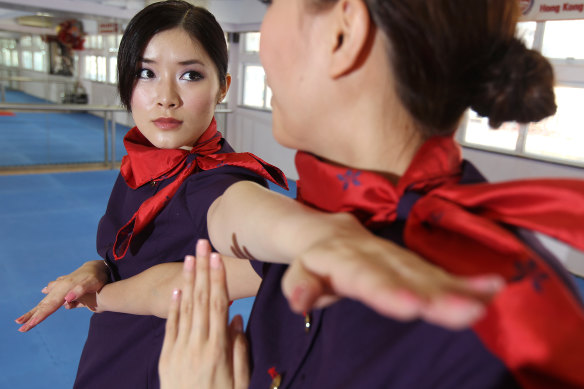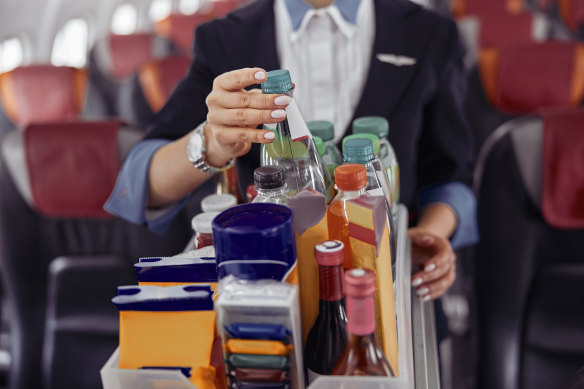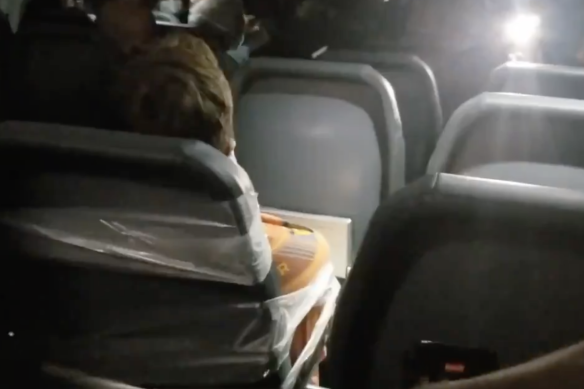Flight attendant reveals how crew deal with aggressive passengers
By Jay Robert
In-cabin brawls seem to feature in the newspapers almost every week. In February 2024 alone, two well-publicised fights erupted on Ryanair flights between Edinburgh and Tenerife. Air rage is officially on the rise in the post-pandemic era around the world. In 2022, the Australian Federal Police were charging, on average, close to 13 people every week at Australian airports. Just this week a Jetstar flight to Bali was forced to turn around due to the behaviour of a passenger (see video below).
What should you expect if you’re caught up in the chaos? Below, cabin crew member Jay Robert, who also runs the aviation industry’s social media community A Fly Guy’s Cabin Crew Lounge, explains how airline staff deal with these incidents – and what you can do to help.

Flight attendants often receive training in martial arts and how to restrain passengers if necessary.Credit: Getty Images
We watch you at the airport
Passenger profiling begins at check-in. Intoxication is the main cause of disruptive inflight behaviour, so ticket counter staff undergo training to identify signs of intoxication. They don’t check in passengers who appear to be under the influence of any substances.
Thanks to online check-in, many passengers now bypass this initial point of contact though. It means that the boarding gate can be the first place for staff to identify anyone with the potential to be aggressive.
As a former airline gate agent at one of the world’s busiest airports, one of my primary objectives was to prevent problematic passengers from boarding the aircraft, while some pilots and flight attendants also conduct an initial scan of passengers pre-boarding. On one occasion, a pilot denied boarding to a passenger at my boarding gate after witnessing their behaviour towards airport restaurant staff while waiting for a takeaway order.
We’re trained for the worst
Aviation security training typically fills at least one, if not two, days of the initial training curriculum for cabin crew. New joiners learn the airline’s specific techniques for restraining violent passengers.
Each airline takes a unique approach: some draw inspiration from military tactics developed by government special forces while others incorporate martial arts. The extent of training provided by an airline often correlates to the duration of its flights, with crew members on long-haul routes receiving more comprehensive training due to the higher number of passengers and limited diversion options.
At my training college, a Taekwondo master taught us restraint techniques that he had developed to manipulate pressure points for effective immobilisation with minimal effort and injury. These skills were regularly refreshed and practised under the guidance of a black belt Taekwondo instructor during our mandatory annual training sessions.
We avoid a fight if possible
Cabin crew remain vigilant throughout the flight, aware that we may need to utilise our training at a moment’s notice. Before every journey, we participate in a pre-flight briefing to assess any potential threats and discuss and strategise about the methods we will employ should any issues arise.

Crew will apply rules for appropriate serving of alcohol in order to limit drunken behaviour on flights.Credit: iStock
Typically, alcohol consumption and the behavioural tendencies of different cultures under its influence are the primary threats to a peaceful flight. Passengers on some routes are infamous for drinking.
To counteract the threat, crew focus on the appropriate serving of alcohol as well as the best non-physical techniques to handle drunks in order to avoid physical confrontation. As a senior crew member, I’d often use a British crew member to handle British passengers: they always seemed to know what to say to get them to simmer down.
Even with the most effective de-escalation techniques, conflicts still arise. The way that the crew handle these depends on several factors, including the scale of the altercation relative to the number of staff. A small crew may require assistance from other passengers to end the disturbance, whereas larger aircraft typically have a larger number of well-trained cabin staff to provide backup and defuse any altercations.
The primary objective is to separate the conflicting parties so that we can safeguard the wellbeing of all passengers and crew. But we have to consider our own safety, which influences our level of involvement in larger disputes.
Airlines often share the success rates of the techniques they teach us, reinforcing our trust in our training and ensuring we stick to our procedures. If aggression is directed towards us rather than other passengers (as is usually the case), it’s easier to deal with: our focus is on maintaining order rather than engaging in physical altercations.
Surprise is our ultimate weapon
In order to maximise the effectiveness of their restraint techniques, airlines don’t share them with the public. Neither do they reveal the tools used by airline crew.
However, airline staff get plenty of experience with communication and excel at it. Our interpersonal skills are the most effective tool that crew members can use before resorting to physical force. We are specially trained to use our verbal abilities in specific patterns to diffuse confrontations.

In 2021, crew on board a Frontier Airlines flight in the US used duct tape to restrain an unruly passenger.Credit: Twitter
If words fail, we’re forced to resort to physical measures. Handcuffs or other types of restraints are commonly available to contain disruptive passengers until the plane lands and law enforcement takes over.
Even with procedures and training, sometimes it’s best to use what we have to hand in order to defend ourselves. A couple of years ago, an American Airlines flight attendant even put a coffee pot to the head of a violent passenger during a domestic flight in the US.
We’re usually grateful for your help
Since September 11, more passengers seem keen to play a role in resolving disruptive behaviour and flight attendants are trained to solicit assistance on some airlines. Other carriers prefer crew to handle incidents, seeking assistance only from passengers who are professionally trained in takedowns, such as police officers or soldiers.
Airlines employing this approach claim it results in fewer injuries and poses less risk of harm to the restrained individual. If you are willing to assist the crew and belong to law enforcement or the military, are certified in martial arts or are a licensed medical professional, you can identify yourself as an ABP (able-bodied passenger) and provide your seat location to the cabin crew.
We sometimes need medical support after the event
In the aftermath of the pandemic, reports of abuse and attacks on cabin crew have reached an all-time high. We carry out our duties so as to safeguard the travelling public, but sadly we seem to be bearing the brunt of the public’s diminished patience and rising aggression.
Far too many of us are finishing our flights with cuts and bruises after abuse from passengers. Following a traumatic incident onboard, it is common practice for a responsible airline to not only provide medical care but also reach out to the crew and see if they require any additional mental health support before they can be deemed fit to resume their flying duties.
We value intel from passengers
They’re our eyes and ears in the cabin and play a crucial role in aviation safety. Many potentially hazardous situations have been identified and rectified thanks to passengers alerting flight attendants after observing suspicious behaviour.
Just as you are encouraged to report suspicious items in airports, I would urge passengers to report any aggressive behaviour from fellow passengers towards ground staff or cabin crew. Even seemingly minor infractions (such as sneaking alcoholic drinks on board) can lead to disruptive behaviour.
The Telegraph, London
Sign up for the Traveller newsletter
The latest travel news, tips and inspiration delivered to your inbox. Sign up now.